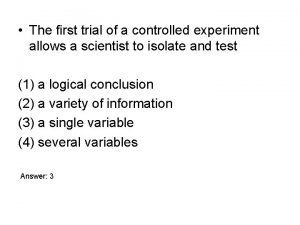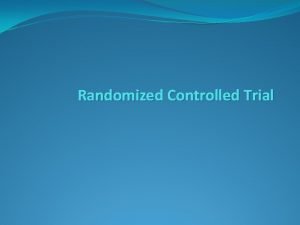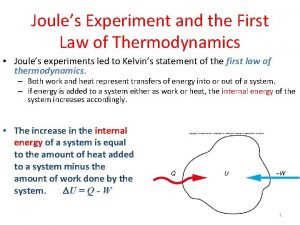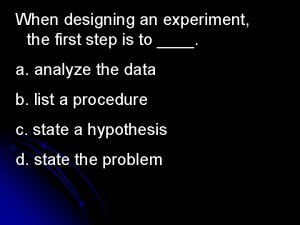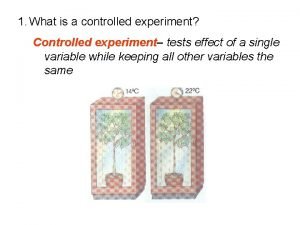The first trial of a controlled experiment allows







- Slides: 7

• The first trial of a controlled experiment allows a scientist to isolate and test (1) a logical conclusion (2) a variety of information (3) a single variable (4) several variables Answer: 3

• An investigator wants to know if an enzyme works best in an acidic or basic environment. She set up 3 groups, one with a neutral p. H, one with a p. H of 3 and one with a p. H of 9. Enzyme activity was measured every 15 minutes. What was the dependent variable and independent variable?

Answer: • IV: p. H level(investigator manipulated) • DV: enzyme activity (responding variable/measured in the end)

• A student studied how the amount of oxygen affects ATP production in muscle cells. The data for amount X are shown in the graph below. • If the student supplies the muscle cells with less oxygen in a second trial of the investigation, a bar placed on the graph to represent the results of this trial would most likely be (1) shorter than bar X and placed to the left of bar X (2) shorter than bar X and placed to the right of bar X (3) taller than bar X and placed to the left of bar X (4) taller than bar X and placed to the right of bar X Answer: 1

• A student prepared a slide of pollen grains from a flower. First the pollen was viewed through the low-power objective lens and then, without moving the slide, viewed through the high-power objective lens of a compound light microscope. • Which statement best describes the relative number and appearance of the pollen grains observed using these two objectives? (1) low power: 25 small pollen grains high power: 100 large pollen grains (2) low power: 100 small pollen grains high power: 25 large pollen grains (3) low power: 25 large pollen grains high power: 100 small pollen grains (4) low power: 100 large pollen grains high power: 25 small pollen grains Answer: 2

• In 1910, Thomas Morgan discovered a certain pattern of inheritance in fruit flies known as sex linkage. This discovery extended the ideas of inheritance that Gregor Mendel had discovered while working with garden peas in 1865. Which principle of scientific inquiry does this illustrate? (1) A control group must be part of a valid experiment. Answer: 2 (2) Scientific explanations can be modified as new evidence is found. (3) The same experiment must be repeated many times to validate the results. (4) Values can be used to make ethical decisions about scientific discovery.

• Which procedure would most likely provide valid results in a test to determine if drug A would be effective in treating cancer in white mice? (1) injecting 1 m. L of drug A into 100 white mice with cancer (2) injecting 1 m. L of drug A into 100 white mice with cancer and 0. 5 m. L of drug X into 100 white mice without cancer (3) injecting 1 m. L of drug A into 100 white mice with cancer and 0. 5 m. L of drug X into another group of 100 white mice with cancer Answer: 4 (4) injecting 1 m. L of drug A into 100 white mice with cancer and 1 m. L of distilled water into another group of 100 white mice with cancer
 The first trial of a controlled experiment allows
The first trial of a controlled experiment allows Advantage of randomized controlled trial
Advantage of randomized controlled trial What are the controlled variables in an experiment
What are the controlled variables in an experiment Control variable in an experiment
Control variable in an experiment First law of thermodynamics joule's experiment
First law of thermodynamics joule's experiment When designing an experiment the first step is to
When designing an experiment the first step is to Hình ảnh bộ gõ cơ thể búng tay
Hình ảnh bộ gõ cơ thể búng tay Frameset trong html5
Frameset trong html5
